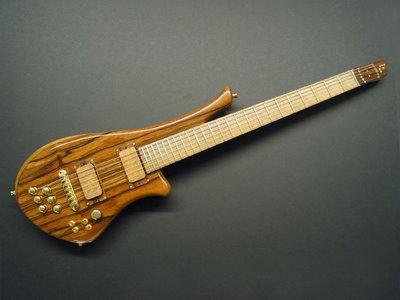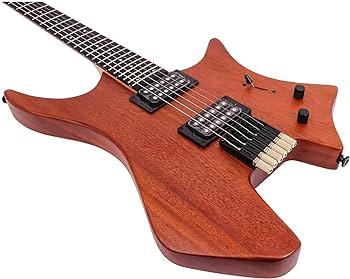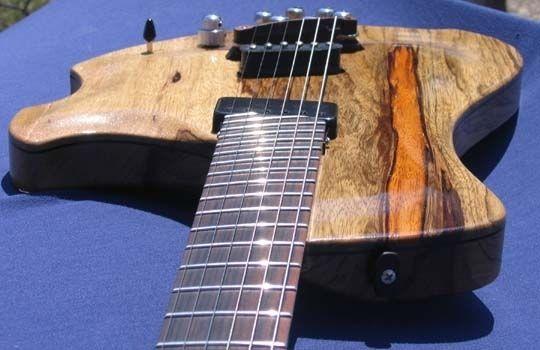Ever been mesmerized by the seemingly unusual design of a headless guitar neck? An odd spectacle at first, its ability to redefine your performance is intimate, profound, and still untold to most. No spoiler alerts here – just a promise of an intriguing journey to exploring how this device can unleash one’s creativity.
As a luthier and researcher, I’ve been immersed in the delicate symphony of stringed instrument construction since 1994. Among the varied patterns, techniques, and styles, a fascinating phenomenon caught my interest – the efficiency of a headless guitar neck. Not just a unique aesthetic appeal, it’s an ergonomic solution reshaping classic traditions in the music realm.
Ahead lies a comprehensive guide I’ve crafted that dives into the what, why and how of headless guitar necks. If you’re contemplating a switch or purchasing your first headless guitar, you’re in for an exciting revelation. More than a mere accessory, it’s a catalyst for more precise tonal control, enhanced playability, and an imagination boom. But the question persists – how has this curious design evolved into a tool of modern guitar craftsmanship?
Embark on this voyage with me to explore the realms of guitar innovation, as we sift through the facts, the myths, and an in-depth understanding of all things headless. Expect material preferences, purchase options, build differences and much more. In the end, you’ll discern whether the allure of a headless guitar neck aligns with your musical expressiveness, or if tradition still holds your heartstrings.
Ready to uncover a craft both intriguing and unconventional? Let’s delve into the world of headless guitar necks to combine ergonomics with acoustics while adding a creative twist to guitar playing. Hold onto your improvisational curiosity – it’s time to turn the tune in favor of creative freedom.
What is a Headless Guitar Neck?
Understanding the Structure and Design

Shaping the crux of a headless guitar neck lies in its structure and design. Having spent years studying and fervently experimenting with various aspects, my insights delve into the very core of ergonomic guitar design, guitar neck profile, and fretboard radius. These not only contribute to its distinct aesthetics but significantly influence the overall playing experience.
Firstly, the ergonomic guitar design is what sets a headless guitar neck apart. It sheds unnecessary mass, paving the way for a lightweight, balanced instrument that puts less strain on your shoulder. Moreover, its compact design fosters easy transportation, a bonus for touring musicians.
The guitar neck profile, or the shape of the back of the neck, is crucial in how comfortable the guitar feels in your hand. From C-shape, U-shape, to V-shape, each profile embeds a unique tactile experience, influencing your dexterity on the fretboard.
Then comes the fretboard radius, the curvature of the fretboard. A smaller radius is excellent for chord work, while a larger one facilitates string bending and soloing. Hence, it’s key to striking the right balance based on personal playing styles, preferences, and physical attributes.
Altogether, a comprehensive understanding of these aspects enhances your ability to assess and choose a headless guitar neck that will truly resonate with your musical aspirations. As we move on to discussing material choices in the next section, remember that the structure and design are the bedrock upon which your guitar’s unique voice will be built.
Material Choices

In the vast universe of luthiery, material choices significantly affect a guitar’s overall character. From my personal experiences, the materials used for a headless guitar neck play a vital role in molding its tone and tactile appeal. When considering key elements such as a maple neck, rosewood fretboard, and other guitar neck materials, the result you get can be quite distinct.
Maple necks are renowned for their stability, strength, and resonant qualities. They seem to add a certain brightness and sustain to the sound, making them a favorite among many guitarists, myself included. When I craft a maple neck headless guitar, the tonal character and feel are crystal clear yet warm, with a sleek, smooth playability.
On the other hand, a rosewood fretboard does wonders in damping unwanted overtones. It provides a rich and warm sound, making it an excellent pairing with a bright-sounding maple neck. There is also a subtle elegance that comes with rosewood; it is soft to the touch, making it comfortable for long bouts of playing.
Every wood type has its unique sonic fingerprint, and the ultimate choice is driven by the desired sound and feel. Other guitar neck materials can further refine these aspects, like graphite for increased stability or ebony for a faster attack and more pronounced highs. The beauty of this process is discovering how different materials interact with each other to build a guitar’s personality.
The mastery of material choice for a headless guitar neck, therefore, is an insightful journey, the outcome of which helps define its tonal landscape and playability. It’s all about creating a harmonious balance that will unleash your creativity.
Exploring Purchase and Replacement Options
Quality Considerations

As we move forward in our exploration of headless guitar necks, we approach the pivotal aspect of quality considerations. Conjuring from my seasoned experience as a luthier, writer for American Lutherie Journal, and editor of Savart Journal, I’m armed with a wealth of knowledge about guitar construction and modification which indubitably informs the benchmark of quality.
Quality is the crux of resilience and durability in a headless guitar neck. It is a distinctive factor that dictates your guitar’s tonal quality, its harmonious effulgence, and its lifetime longevity. As you navigate finding the perfect match, ingraining a robust understanding of quality will guide you in this pursuit.
What constitutes a quality guitar neck? It’s an intersection of several features; the wood type, craftsmanship precision, finish, and fit – they all contribute to associative quality. A well-crafted guitar neck by a skilled luthier imparts an authentic sound that, along with optimal playing comfort, gives your music a unique character. From the start, guitar construction is a meticulous process, with the quality embedded in every stage – from selecting the right wood, shaping the neck, to the finest of finishes.
Further, when discussing quality, we must consider the possibility of modification. As guitarists, we often crave to customize our instruments for a personalized musical impression. Guitar modification opens up new avenues for expression, each addition or alteration essentially mirroring your musical identity. However, walk this path keeping quality in mind, for every modification augments the guitar’s characteristics, either enriching or diminishing the sound quality and structural stability.
In essence, your understanding of quality steers you closer to a guitar neck that aligns with your ingenuity. As I share my insights on this, remember – every nuanced detail about the construction quality of the headless guitar neck, every minute consideration informs and refines your musical expression. Therefore, keep quality considerations at the forefront of your purchase and replacement explorations, for it is here that you truly begin to unleash creativity through headless guitar necks.
Next, we’ll delve into the intriguing decision between single scale and multiscale options, illuminating their particular advantages and how they impact your musical journey. As we continue on this exploration, let’s weave in this understanding of quality, integrating it into our successive discussions and decisions.
Choosing between Single Scale and Multiscale Options

In my journey of exploration, one of the most crucial aspects I encountered when investigating purchase and replacement options was the decision between a single scale neck and a multiscale headless neck. Both options have their unique benefits, bringing different layers of richness and tonality to your artistic endeavor.
Having had the opportunity to experiment with both options, I’ve come to realise the immense value each brings to the table. Single scale neck guitars possess a classic charm and simplicity. The linear fret alignment provides a universal string tension great for standard tuning, and can be a friendlier option for beginners due to its straightforward design – a single scale length for all strings.
On the other hand, if you are after a broader sonic range and are keen on alternative tunings, the multiscale headless neck can be an unusual but rewarding choice. The frets on multiscale guitars are fanned, each string having a unique scale length which enables an extended tonal range and improved ergonomics. Whether to lend your music a distinctive voice or to experiment and push boundaries, a multiscale neck is a vehicle that encourages creativity.
All this being said, the choice between single scale and multiscale isn’t binary – your unique creative vision should guide your decision. After years of experimenting with both styles, I’ve found that the best guitar for you is the one that lets your creativity, your style, and your unique voice shine the brightest.
As we move on to further considerations and opportunities for customization with headless guitar necks in the succeeding sections, keep reminding yourself of your creative needs and how these options can serve them. It’s about letting your envisioned music guide your choice, resulting in a guitar that’s more than an instrument – it’s an extension to your creativity.
Customizing Your Own Headless Guitar Neck
Choosing a Guitar Kit

Our next step is choosing a guitar kit. Over the years, my journey of customizing guitars has led me to discover the brilliance of customizable guitar kits. For me, these kits have become a game changer on many levels.
Constructed from carefully selected materials, a genuine guitar kit grants you the privilege of building a headless guitar from scratch. Unlike buying a ready-to-play instrument, assembling your own lets you deeply understand your guitar’s anatomy. I believe that the level of intimacy you gain as a guitarist is unparalleled.
A guitar kit constitutes every integral component you need; it’s pretty much your canvas as a guitarist. It enables a higher degree of customization which positively corresponds to the adaptability of your playing style. Another advantage is the sense of accomplishment it gives. Trust me when I say, striking those strings for the first time on a guitar you’ve lovingly built is immensely satisfying.
But remember, not all kits are created equal. Some cater better to certain types of music or playing techniques. Some might offer higher quality wood types or more diverse hardware options. You need to understand your own style and preference to choose a kit that will help build the perfect headless guitar for you.
Whether you’re a beginner or a seasoned veteran, taking this route will not only empower you with a nuanced knowledge of guitar anatomy, but it’ll also offer you an unmatched immersion into the world of self-expression through music. As we transcend into the realm of making music with an instrument you’ve built, you’ll find yourself unraveling a part of your creativity hitherto unknown.
As we move forward, we’ll delve into the intriguing aspects of working with a luthier. This will give you an insight into the art of guitar making from those who have dedicated their lives mastering it.
Working with a Luthier

In my pursuit of guitar neck customization, working with a luthier has been a revelation. The collaboration between a guitarist and a luthier is akin to a fascinating journey of co-creation. My association with luthiers from the New England Luthiers group has revealed how these experts can truly fine-tune the instrument to mirror your individual playing style and sonic preferences. Their key contributions become evident while adapting the headless guitar neck design to meet specific user needs.
As a staunch believer in personalization, I’ve come to appreciate how luthiers remarkably infuse their craftsmanship into the intricate customization of guitar necks. Their keen eye for detail and adherence to customizable features pivotally contributes to the overall playability and intonation of your guitar. When it comes to the relevance of their role, it permeates every single aspect of guitar craftsmanship – from material choices to quality considerations, and from deciding between single scale and multiscale options, to zeroing in on a suitable guitar kit.
In retrospect, the luthier’s role has been instrumental to me in truly unleashing my creativity. As we progress in our discussion on headless guitar necks, the undeniable impact of luthiers in crafting your unique sound becomes even more prominent. I hope that with these insights, you can partner with a skilled luthier to transform your musical vision into a tangible reality.
FAQs
What is a headless guitar neck?
Why should I consider a headless guitar neck for creativity?
Are there any limitations to using a headless guitar neck?
How does a headless guitar neck impact sound?
Conclusion
In my journey as a luthier, I’ve found immense joy in the practice and understanding the intricacies of a headless guitar neck, sharing my knowledge, and of course, hearing the rich sounds that resonate from this innovate design. The beauty of this guide is that it can serve as a handy reference as you explore options, from material choices to customizing your own guitar neck and working with a luthier.
Therefore, as you delve deeper into your musical journey and contemplate your own purchasing, replacement, or customizing decisions, remember to consider the structure, design, and quality of a headless guitar neck. And while you may be intrigued by single scale and multiscale options, know that the vital aspect is what feels and sounds right for you.
Does the journey end here or is it just the beginning of your exploration into the realm of headless guitar necks? This question lies with you. As a passionate music enthusiast, each step you take brings you a note closer to crafting your unique melody and rhythm.
The essence is not about having a plethora of choices, but how well you make and resonate with those selections. And always keep in mind, every question regarding headless guitar necks you may have is valid, and answering them can enrich your overall experience.
Therefore, your journey doesn’t end here; instead, it’s an ongoing journey of creativity, innovation, and musical exploration. My sincere hope is that this guide proves a valuable companion, inspiring you to create the beautiful music that the world is yet to hear.

Another incredible article from you!
thank you so much for such a wonderful gift of knowledge and wisdom